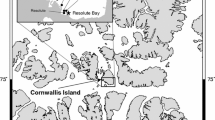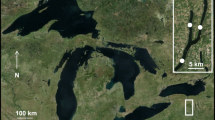Abstract
Lake Champlain continues to experience mercury contamination resulting in public advisories to limit human consumption of top trophic level fish such as walleye. Prior research suggested that mercury levels in biota could be modified by differences in ecosystem productivity as well as mercury loadings. We investigated relationships between mercury in different trophic levels in Lake Champlain. We measured inorganic and methyl mercury in water, seston, and two size fractions of zooplankton from 13 sites representing a range of nutrient loading conditions and productivity. Biomass varied significantly across lake segments in all measured ecosystem compartments in response to significant differences in nutrient levels. Local environmental factors such as alkalinity influenced the partitioning of mercury between water and seston. Mercury incorporation into biota was influenced by the biomass and mercury content of different ecosystem strata. Pelagic fish tissue mercury was a function of fish length and the size of the mercury pool associated with large zooplankton. We used these observations to parameterize a model of mercury transfers in the Lake Champlain food web that accounts for ecosystem productivity effects. Simulations using the mercury trophic transfer model suggest that reductions of 25–75% in summertime dissolved eplimnetic total mercury will likely allow fish tissue mercury concentrations to drop to the target level of 0.3 μg g−1 in a 40-cm fish in all lake segments. Changes in nutrient loading and ecosystem productivity in eutrophic segments may delay any response to reduced dissolved mercury and may result in increases in fish tissue mercury.



Similar content being viewed by others
References
Chalmers AT, Argue DM, Gay DA, Brigham ME, Schmitt CJ, Lorenz DL (2011) Mercury trends in fish from rivers and lakes in the United States, 1969–2005. Environ Monit Assess 175(1–4):175–191. doi:10.1007/s10661-010-1504-6
Chen CY, Folt CL (2000) Bioaccumulation and diminution of arsenic and lead in a freshwater food web. Environ Sci Technol 34:3878–3884
Chen CY, Folt CL (2005) High plankton biomass and abundance reduce mercury biomagnifications. Environ Sci Technol 39:115–121
Chen CY, Folt CL, Stemberger RS, Blum JD, Klaue B, Pickhardt PC (2000) Accumulation of heavy metals in food web components across a gradient of lakes. Limnol Oceanogr 45:1525–1536
Chen CY, Stemberger RS, Kamman NC, Mayes B, Folt CL (2005) Patterns of Hg bioaccumulation and transfer in aquatic food webs across multi-lake studies in the northeast US. Ecotoxicology 14:135–147
Chen CY, Kamman N, Williams J, Bugge D, Taylor V, Jackson B, Miller E (2011) Spatial and temporal variation in mercury bioaccumulation by zooplankton in Lake Champlain (North America). Environ Poll. doi:10.1016/j.envpol.2011.08.048
Driscoll CT, Yan C, Schofield CL, Munson R, Holsapple J (1994) The mercury cycle and fish in the Adirondack lakes. Environ Sci Technol 28:136–143
Driscoll CT, Han Y-J, Chen CY, Evers DC, Lambert KF, Holsen TM, Kamman NC, Munson RK (2007) Mercury contamination in forest and freshwater ecosystems in the northeastern United States. Bioscience 57:17–28
Gao N, Armatas NG, Shanley JB, Kamman NC, Miller EK, Keeler GJ, Scherbatskoy T, Holsen TM, Young T, McIlroy L, Drake S, Olsen B, Cady C (2006) A mass balance assessment for mercury in Lake Champlain. Environ Sci Technol 40:82–89
Hammerschmidt CR, Fitzgerald WF (2006) Methylmercury in freshwater fish linked to atmospheric mercury deposition. Environ Sci Technol 40:7764–7770
Jackson B, Taylor V, Baker RA, Miller E (2009) Low-level mercury speciation in freshwaters by isotope dilution GC-ICP-MS. Environ Sci Technol 43:2463–2469
Kamman NC, Lorey PM, Driscoll CT, Estabrook R, Major A, Pientka B (2004a) Assessment of mercury in waters, sediments, and biota of VT and NH lakes using a geographically randomized design. Environ Toxicol Chem 23:5
Kamman NC, Driscoll CT, Estabrook R, Evers DC, Miller EK (2004b). Biogeochemistry of mercury in Vermont and new Hampshire Lakes. comprehensive final report to the USEPA Office of Research and Development. http://www.vtwaterquality.org/lakes/docs/lp_remap-datareport.pdf. Accessed 4 May 2011
Kamman NC, Burgess NM, Driscoll CT, Simonin H, Estabrook R, Hutcheson M, Major A, Shuehammer A, Scruton D (2005) Mercury in freshwater fish tissues of northeast North America–a geographic perspective based on fish tissue monitoring databases. Ecotoxicology 14:1–2
Karimi R, Chen CY, Pickhardt PC, Fisher NS, Folt CL (2007) Stoichiometric controls of mercury dilution by growth. Proc Natl Acad Sci 104:7477–7482
LCBP (Lake Champlain Basin Program) (2011) Lake Champlain atlas http://www.lcbp.org/Atlas/HTML/nat_lakefax.htm. Accessed 4 May 2011
Masson S, Pinel-Alloul B, Dutilleul P (2004) Spatial heterogeneity of zooplankton biomass and size structure in southern Quebec lakes: variation among lakes and within lake among epi-, meta-, and hypolimnion strata. J Plankton Res 26:1441–1458
Orihel DM, Paterson MJ, Gilmour CC, Bodaly RA, Blanchfield PJ, Hintelmann H, Harris RC, Rudd JWM (2006) Effect of loading rate on the fate of mercury in littoral mesocosms. Environ Sci Technol 40:5992–6000
Orihel DM, Paterson MJ, Blanchfield PJ, Bodaly RA, Gilmour CC, Hintelmann H (2008) Temporal changes in the distribution, methylation, and bioaccumulation of newly deposited mercury in an aquatic ecosystem. Environ Poll 154:77–88
Pickhardt PC, Folt CL, Chen CY, Klaue B, Blum JD (2002) Algal blooms reduce the uptake of methylmercury in freshwater food webs. Proc Natl Acad Sci 99:4419–4423
Shanley JB, Donlon AF, Scherbatskoy T, Keeler GJ (1999) Mercury cycling and transport in the Lake Champlain basin. In: Manley TO Manley PL (eds), Lake Champlain in transition: from research toward restoration, American Geophysical Union Water and Science Application No 1, p 277–299
Simonin HA, Loukmas JJ, Skinner LC, Roy KM (2008) Lake variability: factors controlling mercury concentrations in New York State fish. Environ Poll 154:107–115
Stemberger RS, Chen CY (1998) Fish tissue metals and zooplankton assemblages of northeastern U.S. lakes. Can J Fish Aquat Sci 55:339–352
VTDEC (Vermont Department of Environmental Conservation) (2011a) Lake Champlain monitoring work plan. http://www.anr.state.vt.us/dec//waterq/lakes/docs/lcmonitoring/lp_lc-ltmworkplan.pdf. Accessed 4 May 2011
VTDEC (Vermont Department of Environmental Conservation) (2011b) Lake Champlain monitoring: lake alkalinity http://www.vtwaterquality.org/lakes/docs/lcmonitoring/lp_lc-alkalinity.pdf. Accessed 4 May 2011
Acknowledgments
We thank Arthur Baker, Elizabeth Traver, and Tessa Peart for Laboratory and Field assistance. This research was supported by US National Oceanic and Atmospheric Administration grants NA06OAR4600222 and NA09OAR4600162 as part of the Lake Champlain Research Consortium. The Vermont Agency of Natural Resources and the US Geological Survey provided data and research support. This work was also supported by NIH Grant Number P42 ES007373 from the National Institute of Environmental Health Sciences.
Author information
Authors and Affiliations
Corresponding author
Rights and permissions
About this article
Cite this article
Miller, E.K., Chen, C., Kamman, N. et al. Mercury in the pelagic food web of Lake Champlain. Ecotoxicology 21, 705–718 (2012). https://doi.org/10.1007/s10646-011-0829-4
Accepted:
Published:
Issue Date:
DOI: https://doi.org/10.1007/s10646-011-0829-4




